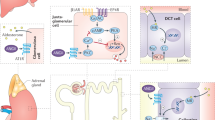Abstract
The renal acid protease renin selectively cleaves its plasma substrate angiotensinogen to release the decapeptide angiotensin I, which in turn is cleaved by a carboxydipeptidase converting enzyme to yield the pressor octapeptide angiotensin II1. It is generally accepted that the renin–angiotensin system has a physiological role in blood pressure and electrolyte homeostasis2, and that abnormalities of the system contribute to certain forms of hypertension3. We previously showed that reduction of the Leu10–Leu11 scissile peptide bond in the (6–13) octapeptide sequence 2 of equine angiotensinogen produced potent and selective inhibitors of canine plasma renin5. We have now used the same approach to modify the recently elucidated N-terminal sequence6 of human angiotensinogen and report here the production of highly active and species-specific in vitro inhibitors of endogenous human renin cleaving renin substrate in human plasma. Whereas the (6–13) octapeptide H-112 of human angiotensinogen is only a weak inhibitor of human plasma renin (IC50 = 313 µM), the analogue H-113, in which the scissile Leu–Val bond has been reduced, has IC50 = 0.19 µM. Extension of H-113 with Pro at the N-terminus and with Lys at the C-terminus7, giving the decapeptide derivative H-142, increases inhibitory potency further (IC50 = 10 nM). We believe that the high in vitro inhibitory potencies of H-113 and H-142 are due to the ability of the reduced moiety —CH2—NH— to act as a non-hydrolysable analogue of the tetrahedral transition state formed during hydrolysis of the (10–11) peptide bond. H-113 and H-142 are strongly species specific, and are highly specific for renin among acid proteases: H-142 has no inhibitory effect in vitro on human cathepsin D or renal acid protease at a concentration of 712 µM.
This is a preview of subscription content, access via your institution
Access options
Subscribe to this journal
Receive 51 print issues and online access
$199.00 per year
only $3.90 per issue
Buy this article
- Purchase on Springer Link
- Instant access to full article PDF
Prices may be subject to local taxes which are calculated during checkout
Similar content being viewed by others
References
Skeggs, L. T., Dorer, F. E., Levine, M., Lentz, K. E. & Kahn, J. R. in The Renin-Angiotensin System (eds Johnson, J. A. & Anderson, R. R.) 1–27 (Plenum, New York, 1980).
MacGregor, G. A., Markandu, N. D., Roulston, J. E., Jones, J. C. & Morton, J. J. Nature 291, 329–331 (1981).
Atkinson, A. B. et al. in The Therapeutics of Hypertension, 29–61 (Academic Press and The Royal Society of Medicine, London, 1980).
Parry, M. J., Russell, A. B. & Szelke, M. in Chemistry and Biology of Peptides (ed. Meienhofer, J.) 541–544 (Ann Arbor Science, Ann Arbor, 1972).
Szelke, M. et al. Hypertension 4, Suppl. II, 59–69 (1982).
Tewksbury, D. A., Dart, R. A. & Travis, J. Biochem. biophys. Res. Commun. 99, 1311–1315 (1981).
Burton, J., Cody, R. J., Herd, J. A. & Haber, E. Proc. natn. Acad. Sci. U.S.A. 77, 5476–5479 (1980).
Skeggs, L. T., Kahn, J. R., Lentz, K. & Shumway, N. P. J. exp. Med. 106, 439–453 (1957).
Skeggs, L. T., Lentz, K. E., Hochstrasser, H. & Kahn, J. R. Can. med. Ass. J. 90, 185–189 (1964); J. exp. Med. 128, 13–34 (1968).
Kokubu, T. et al. Nature 217, 456–457 (1968).
Kokubu, T. et al. Biochem. Pharmac. 22, 3217–3223 (1973).
Poulsen, K., Burton, J. & Haber, E. Biochemistry 12, 3877–3882 (1973).
Burton, J., Poulsen, K. & Haber, E. Biochemistry 14, 3892–3898 (1975).
Haber, E. & Burton, J. Fedn Proc. 38, 2768–2773 (1979).
Quinn, T. & Burton, J. in Peptides (eds Rich, D. H. & Gross, E.) 443–445 (Pierce Chemical Company, Rockford, 1981).
Lienhard, G. E. Science 180, 149–154 (1973).
Hille, M. B., Barrett, A. J., Dingle, J. T. & Fell, H. B. Expl Cell. Res. 61, 470 (1970).
Barany, G. & Merrifield, R. B. in The Peptides (eds Gross, E. & Meienhofer, J.) 1–284 (Academic, New York, 1980).
Chillemi, N. & Merrifield, R. B. Biochemistry 8, 4344–4346 (1969).
Brown, T. & Jones, J. H. J. chem. Soc. chem. Commun. 648 (1981).
Yamashiro, D. & Li, C. H. J. Am. chem. Soc. 95, 1310–1315 (1973).
Erickson, B. W. & Merrifield, R. B. J. Am. chem. Soc. 95, 3757–3763 (1973).
Felix, A. M. & Jimenez, M. H. Analyt. Biochem. 52, 377–381 (1973).
König, W. & Geiger, R. Chem. Ber. 103, 788–798 (1970).
Szelke, M. et al. in Molecular Endocrinology (eds MacIntyre, I. & Szelke, M.) 57–70 (Elsevier, Amsterdam, 1977).
Ito, A., Takahashi, R. & Baba, Y. Chem. Pharm. Bull. 23, 3081–3087 (1975).
Szelke, M., Hallett, A. & Jones, D. M. European Patent Application 0-045-665 (February 1982).
Millar, J. A., Leckie, B. J., Morton, J. J., Jordan, J. & Tree, M. Clinica chim. Acta 101, 5–15 (1980).
Poulsen, K. & Jörgensen, J. J. clin. Endocr. Metab. 39, 816–815 (1974).
Hackenthal, E., Hackenthal, R. & Hilgenfeldt, U. Biochim. biophys. Acta 522, 574–588 (1978).
Author information
Authors and Affiliations
Rights and permissions
About this article
Cite this article
Szelke, M., Leckie, B., Hallett, A. et al. Potent new inhibitors of human renin. Nature 299, 555–557 (1982). https://doi.org/10.1038/299555a0
Received:
Accepted:
Issue Date:
DOI: https://doi.org/10.1038/299555a0
This article is cited by
-
Convergent synthesis of aminomethylene peptidomimetics
Nature Protocols (2012)
-
Biochemical properties of renin and prorenin binding to the (pro)renin receptor
Hypertension Research (2010)
-
Emerging principles in protease-based drug discovery
Nature Reviews Drug Discovery (2010)
-
Aliskiren: the first renin inhibitor for clinical treatment
Nature Reviews Drug Discovery (2008)
-
Renin inhibition
Cardiovascular Drugs and Therapy (1995)
Comments
By submitting a comment you agree to abide by our Terms and Community Guidelines. If you find something abusive or that does not comply with our terms or guidelines please flag it as inappropriate.



